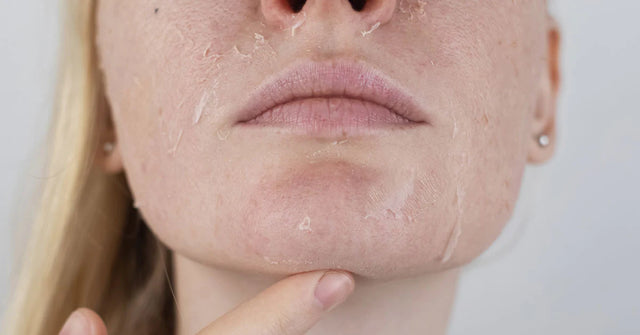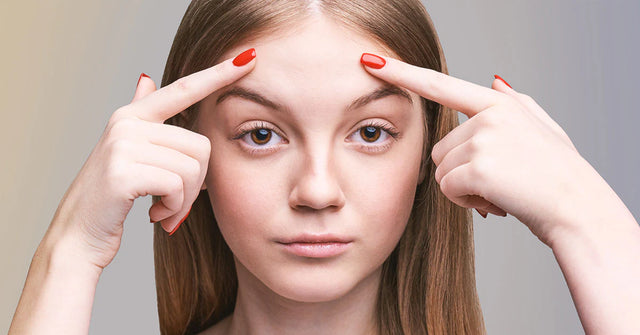Acne is a skin condition that is widespread among adolescents due to hormone changes, and it doesn't always disappear in adulthood. In fact, it may even intensify due to factors like environmental pollution, pregnancy, menstruation, stress, or excessive sweating. If you have acne-prone skin, it's important to follow a skincare routine using high-quality products to diminish blemishes.
Acne occurs when pores become clogged by dead skin cells or excessive sebum production. In the following sections, we'll share how to build a skincare routine for acne.
What Causes Acne on Your Skin?
Acne is a chronic, widespread condition that, contrary to popular belief, is not only caused by improper skin hygiene. In reality, people who have acne often cleanse their skin too much! The main cause of acne is the overproduction of oil called sebum in the sebaceous glands, which may clog pores and cause blackheads and pimples.
Acne most often appears on your forehead, face, chest, upper back, shoulders, and to a lesser extent on your legs, because in these areas the skin has the largest number of sebaceous glands. Other causes of acne, especially facial acne, vary and may include:
● Hormonal changes
● Genetic factors
● Excessive sweating
● Poor skincare routine
● Cosmetic products that contain irritants, oils, or perfumes
● An unhealthy diet
● Stress or lack of sleep
Significant improvement in your acne requires consistent treatment. Although it seems like a simple tip, choose a specific time to carry out your regimen so that it becomes a habit. In addition, it’s important to develop a strong, effective routine using quality products. The following sections explain how to build a skincare routine for acne.
Acne Skincare Regimen For The Morning
During the day your skin may be exposed to factors that negatively affect its appearance and health, including the sun's rays, environmental pollution, changes in weather, sweat, and impurities. The following sections explain how to build a skincare routine for oily, acne-prone skin. You’ll also learn how to build a skincare routine for acne scars to reduce blemishes and protect your complexion, so you always look radiant.
Step #1 - Cleanse
Having a healthy, blemish-free complexion begins with a good cleanse. Cleansing eliminates dead cells and oil, and it prevents dirt and impurities from accumulating on your skin and clogging the pores.
For optimal results, choose a quality product and use it twice daily. A cleanser such as Rejuvoderm that contains salicylic acid will penetrate deeply to unclog your pores, reduce the size of blackheads, and eliminate blemishes.
Step #2 - Tone
The next step in your morning routine is to apply a toner, which helps to even out tone and remove any dirt remaining on the skin’s surface. Toners are light and many contain active ingredients like hyaluronic acid to treat wrinkles and fine lines, vitamin C for blemishes and dark spots, and salicylic acid to heal acne.
While not all individuals find using a toner essential to their daily routines, they do offer numerous benefits for all skin types including those that are oily and acne prone, and in the case of Maxatone, also work to hydrate and balance pH levels.
Step #3 - Moisturize
If you want to treat acne, forget the myth that oily skin doesn't have to be moisturized. Moisturizing creams don’t add oil, on the contrary, applying a quality treatment helps control the release of sebum and create a mattifying effect on your skin.
Hydration is key to keeping your skin healthy and luminous, and it’s particularly important if you are prone to developing acne. In the absence of moisture, your skin produces more oil, which can exacerbate existing blemishes. When your complexion is sufficiently hydrated, it forms a highly effective barrier that protects from external agents such as cold, wind, or pollution.
How to Choose the Optimal Moisturizer
● Antioxidants: Look for a moisturizer that includes antioxidant-rich ingredients such as squalane, grape seed extract, and vitamin E. These extracts are safe for every skin type and will make your skin look fresh and healthy.
● Oily or Acne-prone Skin: Purchase a non-comedogenic facial moisturizer that includes alpha-hydroxy acids.
● Dry Skin: Buy a richly moisturizing cream that contains deeply hydrating ingredients like glycerin, botanical oils, and hyaluronic acid.
● Sensitive Skin: If you have sensitive skin, look for a product that contains no more than ten active ingredients such as our light gel-cream daily moisturizer Infusoderm, as this limits your skin’s interactions with potentially damaging substances.
Step #4 - Use Sunscreen
When the weather changes and summer gives way to fall and winter, many people automatically close the cap on their sunscreen until the good weather returns. However, solar radiation exists in every season, and even if you cover up well your face will still be exposed to UV rays. For this reason, you should continue to use sunscreen in all weather conditions.
Sunscreen prevents the sun from drying out and damaging your skin. While it is important to wear a sun protection product, if you don’t choose the right formula you risk clogging your pores and causing breakouts.
How to Choose the Ideal Sunscreen
Choose a sunscreen product with ingredients like zinc oxide, which helps regulate sebaceous secretion. Look for a brand that is oil-free and non-comedogenic, meaning it will not clog your pores. And if you want to save time in the morning, pick one that also does double-duty as a daily moisturizer such as Dermaxsol.
Acne Skincare Regimen For The Evening
Naturally, during the day, your skin collects dirt and absorbs impurities that may negatively impact its appearance. If you want to keep your skin clean and fresh at all times, you should also follow a night facial care routine. In this section, you’ll learn how to build a skincare routine for dry acne-prone skin at night.
Step #1 - Cleanse
Cleansing is the first and most essential step in our recommended nighttime skincare routine. Ensure that you wash your face thoroughly before bed, especially if you wear makeup. Cleansing helps prevent clogged pores, and it removes sweat, dirt, and excess sebum from your skin.
At night, you can use your morning facial cleanser to remove oil, makeup, and dirt that accumulates daily in your pores. A clean, purified complexion keeps excessive oil production at bay and prepares the dermis for additional skincare products.
Step #2 - Apply Acne Treatments
It’s important to include an acne treatment in your nighttime routine, as they include a number of concentrated nutrients for skin health. In addition, these products treat specific skin issues such as hyperpigmentation, uneven skin texture, premature aging, and dullness. Look out for creams and serums that have salicylic, lactic, or glycolic acid.
Step #3 - Moisturize
The final step in your nighttime skin routine should be a deeply hydrating moisturizing cream. Moisturizing heals a dry, flaky complexion, plumps to smooth lines and wrinkles, and gets rid of excess oil. Oily skin needs nourishment, and your go-to product should be non-comedogenic to avoid clogging your pores.
FAQs
What is the daily routine for acne-prone skin?
Cleansing thoroughly on a regular basis is crucial if you have oily skin. Good morning and nighttime skincare routines eliminate the pollutants, oil, and grime that can clog pores and cause whiteheads, blackheads, or blemishes. You’ll get all these benefits and more by following our easy and affordable routine for acne-prone skin.
How do you take good care of your skin in order to avoid acne?
If you follow an effective skincare routine using safe, quality products, the health of your complexion will improve and it should also prevent breakouts. Some additional tips for preventing acne include:
● Washing your face twice a day
● Avoiding soaps with chemical ingredients
● Abstaining from pinching or popping your pimples
● Using high-quality skincare products
● Wearing sunscreen daily
What's the affordable skincare routine for acne-prone skin?
An affordable skincare routine includes only three to four simple steps, and it is well worth the time and money for the long and short-term benefits to your complexion. Do not use products that are ill-suited to your skin type, and look for brands that include safe, science-backed ingredients.
Conclusion
Clear, smooth skin does not develop overnight, so you have to be persistent to see results. Use quality, science-backed products for acne-prone skin, and be consistent with your routine. We highly recommend that you explore our product range to treat acne and enhance your overall skin health.
Mentioned in this article
More stories

How To Get Rid of Peeling Skin: 4 Effective Steps







